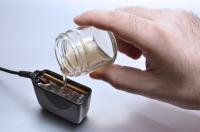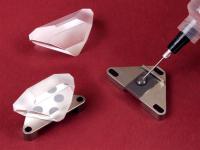
Adhesive serviceability at cold temperatures presents a number of challenges. Often, adhesives will crack at lower temperatures. Others will debond/delaminate from a substrate material. Epoxy adhesives in particular do very well at low temperatures. They actually increase in bond strength and their physical properties are higher than at room temperatures. In fact many epoxies can be used in cryogenic applications for bonding, sealing, potting/encapsulation. Select silicone systems perform well at -40°C to -50°C. Other special formulations are designed to withstand -100°C. It is important to note that these silicone systems remain highly flexible at low temperatures. Epoxy polysulfides and urethane-modified epoxies are also noted for their serviceability at low temperatures.
Performance properties of adhesives designed for low temperature environments
Master Bond has been at the forefront in the development of adhesives for low temperature environments. These one and two component compounds are blended with unique ingredients/fillers that are engineered to optimize mechanical/chemical/electrical performance. These products are available in flowable/ non sag viscosities and can be dispensed with automatic, semi-automatic and manual applicators. Our line of adhesives includes electrically conductive systems, thermally conductive/electrically insulative systems, optically clear formulas and NASA low outgassing products. They are presently employed in the assembly of:
- honeycomb sandwich structures
- vessels and tanks
- automotive parts
- electrical enclosures
- transformers
- deep submergence vehicles
- refrigeration equipment
To ensure bonded joint durability/longevity careful consideration should be given to length of low temperature exposure, temperature variations and rate of temperature change. Adhesive selection is also dependent on the types of substrates being joined, configuration of the parts and bond line thickness.
Most Popular Master Bond Low Temperature Resistant Adhesives
 |
MasterSil 157 Two component low viscosity silicone system. Ideal for potting and encapsulation. Does not require air for curing. Low exotherm; very long pot life. Enhanced low temperature serviceability. Service temperature range of -175°F to +500°F. Superior electrical insulator. |
 |
MasterSil 415 Optically clear, room temperature curing, no mix acetoxy type system. Good bond strength and outstanding elasticity. Serviceable from -185°F to 400°F. |
 |
MasterSil 803 Unique non-corrosive neutral curing oxime type silicone featuring enhanced high and low temperature serviceability from -180°F up to +500°F(260°C). Features high bond strength and superior electrical insulation properties. Paste viscosity. |
 |
EP21TDCHT High strength, high temperature resistant, two part system with excellent bond strength and thermal cycling capabilities. Serviceable from -100°F to +350°F. Meets MIL-STD-883J Section 3.5.2 for thermal stability. Moderate viscosity. Superior toughness. Withstands vibration, impact, shock. Good dimensional stability. Convenient one to one mix ratio. Dependable electrical insulation properties. |
 |
EP29LPSP Two part epoxy system with ultra low viscosity and remarkable cryogenic properties. Withstands rapid drop in temperature and is NASA low outgassing approved. Optically clear. Long working life. Low exotherm. Excellent resistance to acids, bases and many solvents. Outstanding electrical insulative properties. Service operating temperature range from 4K to +275°F. |
 |
EP37-3FLF Highly flexible, low viscosity, optically clear adhesive. Resistant to severe thermal cycling and thermal shock. Bonds well to dissimilar substrates. Low exotherm system. Long working life. Superior electrical insulation properties. Service temperature range from 4K to +250°F. One to one mix ratio by weight or volume. |
